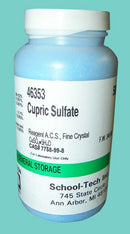Description
Cupric sulfate (copper(II) sulfate) reagent fine crystals are widely used in classrooms for chemistry experiments and demonstrations, primarily due to their distinct blue color and diverse chemical properties. Common educational uses include:
-
Chemical Reactions and Color Changes: Cupric sulfate is often used in experiments to demonstrate various chemical reactions, such as double displacement reactions and redox reactions. For example, when zinc metal is placed in a solution of cupric sulfate, a redox reaction occurs, producing copper metal and zinc sulfate.
-
Electrolysis and Electroplating: Cupric sulfate is commonly used in electrochemistry experiments to demonstrate the principles of electrolysis. Students can use it to deposit a layer of copper on a metal object, illustrating the concept of metal plating.
-
Crystallization and Hydration Studies: Cupric sulfate crystals are ideal for studying crystallization and hydration. In its hydrated form (CuSO₄•5H₂O), it is a vibrant blue, but it turns white upon heating when it loses its water molecules. This change is used to teach about the effects of hydration and dehydration on compounds.
-
Identifying Presence of Water: Cupric sulfate can also be used as a qualitative test for water. The blue hydrated form turns white when heated (as it becomes anhydrous), and when a drop of water is added to the anhydrous form, it turns blue again. This makes it an excellent tool for illustrating reversible hydration reactions.
-
Demonstrating Copper Ion Properties: The distinct blue color of cupric sulfate is due to the presence of copper(II) ions in solution. It is often used to teach students about the behavior of transition metals and their unique colors in aqueous solutions.
Cupric sulfate should be handled carefully, as it is toxic if ingested and can cause irritation to skin and eyes. Proper safety equipment, including gloves and goggles, should be used during experiments.

